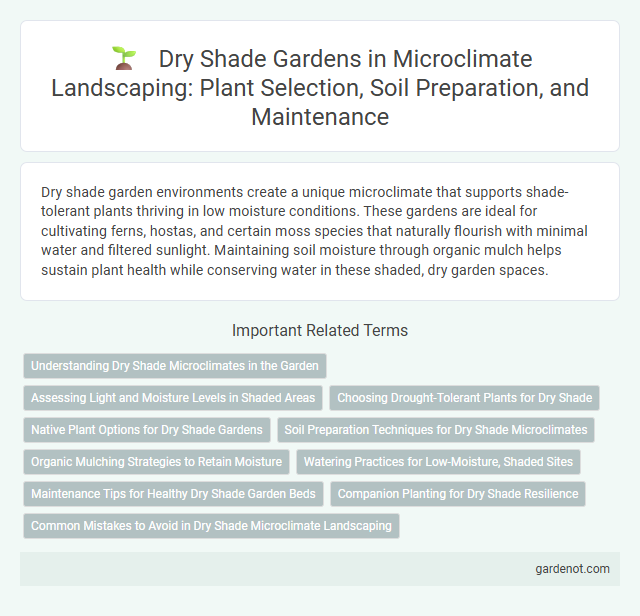Dry shade garden environments create a unique microclimate that supports shade-tolerant plants thriving in low moisture conditions. These gardens are ideal for cultivating ferns, hostas, and certain moss species that naturally flourish with minimal water and filtered sunlight. Maintaining soil moisture through organic mulch helps sustain plant health while conserving water in these shaded, dry garden spaces.
Understanding Dry Shade Microclimates in the Garden
Dry shade microclimates in the garden occur where tree canopies or structures block sunlight, reducing moisture availability and air circulation. Plants in these areas must tolerate low light levels and limited water, thriving in conditions that mimic natural woodland understories with well-drained soil. Selecting drought-resistant species adapted to shade, such as ferns, hostas, and certain ornamental grasses, ensures garden resilience and aesthetic appeal.
Assessing Light and Moisture Levels in Shaded Areas
Assessing light and moisture levels in dry shade gardens requires precise measurement of sunlight intensity and soil hydration to ensure plant survival. Use tools such as light meters and soil moisture sensors to capture data on the limited sunlight and reduced water availability typically found under tree canopies or structures. Understanding these environmental factors enables the selection of drought-tolerant, shade-loving species, optimizing garden health and sustainability.
Choosing Drought-Tolerant Plants for Dry Shade
Selecting drought-tolerant plants such as ferns, hostas, and Japanese forest grass ensures thriving growth in dry shade garden microclimates with limited water availability. These species possess deep root systems and adaptive traits that efficiently utilize minimal moisture and withstand prolonged dry periods beneath dense tree canopies. Incorporating native drought-resistant plants enhances soil health, reduces irrigation needs, and promotes sustainable microclimate management in shaded, arid garden spaces.
Native Plant Options for Dry Shade Gardens
Native plant options for dry shade gardens include species such as Western bleeding heart (Dicentra formosa), Oregon grape (Mahonia aquifolium), and California fuchsia (Epilobium canum). These plants are adapted to low light and limited moisture, thriving under tree canopies with minimal irrigation. Incorporating native ferns like Polystichum munitum and shade-tolerant grasses like Carex spp. enhances biodiversity while conserving water in dry shade microclimates.
Soil Preparation Techniques for Dry Shade Microclimates
Soil preparation in dry shade gardens requires improving moisture retention and nutrient availability by incorporating organic matter such as compost or well-rotted leaf mold. Amending the soil with materials like biochar or coconut coir enhances aeration and water-holding capacity in poorly draining, compacted soils typical of shaded areas. Ensuring a loose, well-drained soil structure helps sustain healthy root systems and supports drought-tolerant shade plants in microclimates with limited sunlight and low moisture.
Organic Mulching Strategies to Retain Moisture
Organic mulching in dry shade gardens plays a crucial role in retaining soil moisture by reducing evaporation and regulating temperature fluctuations. Materials such as shredded bark, leaf litter, and composted wood chips create a protective layer that enhances soil structure and promotes microbial activity essential for plant health. Applying a 2-4 inch mulch layer around shade-tolerant plants significantly improves moisture retention while suppressing weeds and preventing soil erosion.
Watering Practices for Low-Moisture, Shaded Sites
Watering practices for dry shade gardens emphasize deep, infrequent irrigation to promote drought-tolerant root systems and prevent fungal diseases common in low-moisture, shaded sites. Utilizing drip irrigation or soaker hoses targets water directly to the root zone, minimizing evaporation and runoff in shaded microclimates. Mulching with organic materials further conserves soil moisture and maintains consistent hydration essential for understory plants in dry shade conditions.
Maintenance Tips for Healthy Dry Shade Garden Beds
Dry shade garden beds thrive with regular mulching to retain moisture and suppress weeds, using organic materials like shredded bark or pine needles. Choosing drought-tolerant plants adapted to low-light conditions, such as ferns, hostas, and epimediums, reduces water requirements and minimizes stress. Soil amendment with compost improves drainage and nutrient availability, while careful monitoring of watering schedules prevents root rot and fosters healthy growth.
Companion Planting for Dry Shade Resilience
Companion planting for dry shade gardens enhances soil moisture retention and improves plant resilience by pairing shade-tolerant species with deep-rooted, drought-resistant companions like ferns and hostas. Utilizing ground covers such as sweet woodruff or lungwort helps reduce evaporation while creating a microclimate that supports moisture-dependent plants under tree canopies. Strategic selection of drought-tolerant companions maximizes nutrient sharing and minimizes water competition, ensuring healthier and more sustainable dry shade garden ecosystems.
Common Mistakes to Avoid in Dry Shade Microclimate Landscaping
Planting moisture-loving species in dry shade areas leads to poor growth and increased maintenance. Overwatering dry shade plants can cause root rot while not improving soil moisture retention. Ignoring soil preparation and failing to amend with organic matter reduces plant resilience in dry shade microclimates.
Dry shade garden Infographic

 gardenot.com
gardenot.com